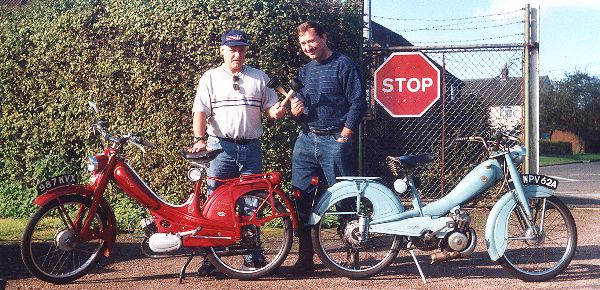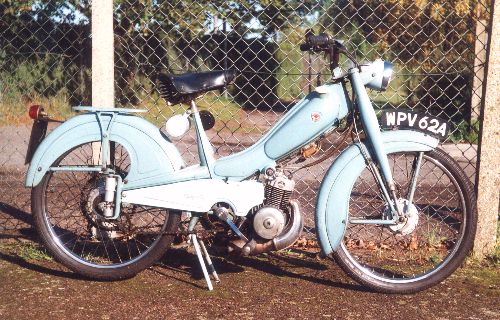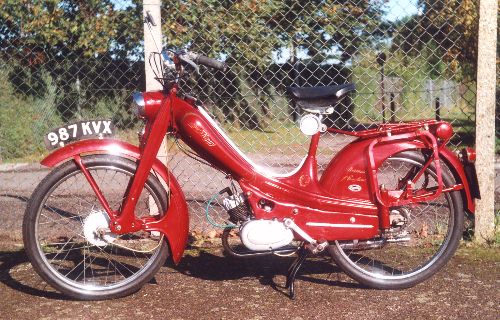 Go
to the Archive index
Go
to the Archive index
If you want to join the Plunger Club, you've got to have the right equipment! A rigid rear or swinging arm just won't do, and we're not talking body parts - this is about a very Particular type of back suspension system. The Mobylette AV78 and Norman Nippy Mk2S have the necessary qualifications, but you'll have to hunt pretty hard to find many others that do.
The system utilises a rigid frame suspended above and below the rear axle on short springs, the upper spring absorbs compression shocks while the lower serves for recoil damping. The rear spindle mounts into sliders that travel up and down rods within the springs, which are covered by shrouds to protect the working components. The method first appeared on some larger motorcycles in the early 1950s, and only started finding its way onto mopeds a little later, after the big boys had progressed beyond it. Achilles introduced plungers on their sprung frame Capri moped from 1956, and Mobylette models employed their version of the principle from 1957. Norman inherited the Capri by acquisition of the tooling and production rights when Achilles ceased trading in 1957, and continued to manufacture their Nippy variant of the model, which they had factored under licence up to this time. As the Villiers 3K motor began to reach the market place by July 1959, it replaced the Sachs engine, so Norman Nippy Mk2S models can be found with either power unit.
The Norman featured in this article is a rare surviving example of one of these earlier Sachs powered machines, built with more stylish imported fittings than the later models. This vehicle was registered in 1958, while its Mobylette cousin dates from 1960. Apart from the plunger suspension systems, the two machines have very little in common - so they should make an interesting comparison.

Now, just to make the soup a little more spicy, the classical AV78 isn't exactly standard! The motor's had an AV89 conversion with 9:1 compression head and big ported barrel, which is given away only by its split fins, where it should normally wear the continuous fin type with small ports. The uprate however is slightly moderated by conservatively fitting an AR 13mm carburettor in place of the BA 10mm, where a 'full blown' AV89 specification would ordinarily use the Gurtner H 14mm. Best guess of this combination would now rate power output around 2.5bhp, raised from 1.4bhp. Gearing remains standard AV78 of 24.4 in low ratio, variating to 13.62 in high ratio.
To even things tip in the playoff, the Norman isn't exactly standard either! The Nippy would normally be fitted with a 1.6bhp 2-gear motor at 6:1 compression, but this little red imp as been installed with an early 2-2.2ps × 3-gear unit. Features of this engine are 1.5mm higher transfer ports in the cylinder and a 7.3:1 compression ratio, though in this case, the head has been significantly skimmed and is running without a gasket, so it's probably somewhere around 10:1 now! Power output is now likely to be in the order of 2.5bhp, and though the motor is still mounting its same 12mm Bing carb, greater flexibility is expected to be afforded from its extra gear, while the 3-speed box also raises its top drive ratio by 13.5%. Overall ratios (with 12T front sprocket) are 35.6 in 1st, 21.6 in 2nd, and 14.45 in 3rd, which still leaves the Norman geared 5.7% below the Moby!

With all the dizzying specification changes to both these machines, it's now difficult to guess who has the technical advantage - so which horse is your money on? To get the Moby away, being an early machine, it's unscrew the petrol tap for open, later models were push/pull. Forward decompress, usual trigger choke, and a very easy starter. The seat's set low for rider comfort, but not mine, so it feels as if you're sitting in this cycle instead of on it. The bars are set to droop at the back so gives a sort of low, slumped riding position that's really not to my taste. Winding on the throttle doesn't deliver quite the same lusty urge as an AV89, so that AR 13 carb appears to have quite a mellowing effect. Mellow it may be, but there's certainly bags more pull than a soggy old standard AV78, which was always somewhat overgeared by the variator, to the power output of the motor. That original speedo's a nice touch with all the mile-o numbers coining up in their own separate windows. A few sweepy bendy bits soon start giving you the feel of that plunger suspension, and it really is very good! All the jarring shocks that come through a rigid machine are smoothed out, and it doesn't jump all over the place on the bumps. The problem of swing-arm mopeds, is the lightweight engineering becomes so marginal that when you ride many of them - well, you know, they feel kind of flexible! The AV78 is beautifully taut at the back, no nasty wobbly habits, yet it smoothes out all the road ripples. Seems like the best of both worlds! What we need to do now is really test the plungers - so, let's off-road! No, it's alright, only joking! The limitations of plungers are their short range of travel, and though they're fine within their capabilities, they readily bottom out when you start hitting bigger bumps. Shorter springs get coil bound quicker, but being realistic, these machines were never built with motocross in mind. For general, light road duties on a commuter moped, plungers are lovely! The Moby ones really look nice quality too, as the sliders and telescopic shrouds are all made out of aluminium, which also shows them off as a feature - exactly what they were at the time.
Now, nipping over to the Norman, and the Sachs carb has no choke, but a quick tickle on the flood button provides the necessary encouragement. Neutral, bit of throttle and stand on a pedal to fire up the motor. UK market Sachs engines were invariably sedentary 1.25ps or 1.6ps models, which turn over quite readily with their low compression ratios. Moving up to the higher rated motors, and the addition of a decompressor really helps to get the crank spinning, or you find an undue amount of effort becomes required to 'kick them off'. The 7.3 head has the option to fit a valve, but the port is blanked by a plug. On this early 2S model, the silencer is actually one of the few British made fittings, though it delivers an untypically crisp crackle that suggests a little 'exhaust tuning' has also been going on. First gear on the Sachs engine feels absurdly low for a single seat machine, and any hills could be capably climbed in 2nd. The front forks ride well, and surprisingly don't pitch upward under braking like so many leading-link systems, so Achilles seem to have got the geometry and spring rates just about spot-on. Just like the Moby, the back-end is firm, yet soaks up the road ripples without any twitches, so again, a really nice ride.
Engineered quite differently to the Moby's telescopic shrouds, the Norman plungers comprise an upright steel tube welded to the frame in place of the axle lug. The tube is slotted vertically up the back to clear the brutally forged steel slider, which travels the internal rod in a conventional manner, between the top and bottom springs. Due to the constructional nature of the Nippy plunger, they become painted with the rest of the cycle components and discretely blend with the rest of the frame, not at all a 'visual feature' as on the AV78. A crucial point with plungers is maintenance, nothing high tech, but ideally suited to the "grease gun hobbyist". Operating loads on the plunger rods and bushes are high, so it's critical to maintain lubrication and preclude dirt entry. In the case of these items, continued use and neglected service will result in the most horrific wear.
So now you know all about the suspension, let's get back to "The Plunger Brothers" and see how the two bikes get on riding together.
Pulling away, the smooth drone of the Mobylette is totally drowned out by the aggressive crackle from the Norman - but to no avail. On standing start acceleration - the Moby wins! Even though the Nippy seems to exhibit more pull in gear, it loses out during the changes and it just isn't possible to beat the consistency of that variator. A couple of hill climbs show the Norman holds a convincing edge, being stronger in its top gear on a long shallow incline, and again on a steeper gradient when cogging down to 2nd. Then on to the straight for top speed, and both machines are pretty much finished at 35 or 36mph - but the Norman just has a slight edge and manages to creep away. (Yes, Lawrence, I know the Moby's not going properly at the moment; but look at the extra weight the Norman's having to carry, and Paul was still sitting bolt upright!), When it comes down to stopping, the finely finished, full width, all aluminium Ideal hubs on the Moby prove to be more than a match for the "spongy" British Hub Co pressed tin examples on the Nippy. (Yes, Paul, I know the new brake linings haven't had time to bed in yet!) I think we'll just call it a draw shall we? Somehow though, one doesn't feel this is quite the end of "The Plunger Brothers" story!
Next edition and we're off on safari to track down one of the rarest animals on the NACC game reserve. There've been reports of occasional sightings over the years, but few real opportunities for spotting many of these creatures. No Buzzing article has ever appeared on any member of the species, so once again, "The Road Test" is to be found padding quietly on new ground. The clues may be a bit easier this time, but the subject has got to be... purrfect!
First published, June 2002